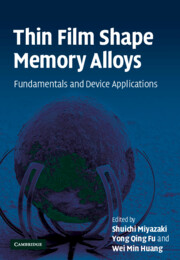Book contents
- Frontmatter
- Contents
- List of contributors
- Preface
- Abstracts of chapters
- 1 Overview of sputter-deposited TiNi based thin films
- 2 Martensitic transformation in TiNi alloys
- 3 Deposition techniques for TiNi thin film
- 4 TiNi multilayer thin films
- 5 Crystallization and microstructural development
- 6 Mechanical properties of TiNi thin films
- 7 Stress and surface morphology evolution
- 8 Ion implantation processing and associated irradiation effects
- 9 Laser post-annealing and theory
- 10 Overview of thin film shape memory alloy applications
- 11 Theory of SMA thin films for microactuators and micropumps
- 12 Binary and ternary alloy film diaphragm microactuators
- 13 TiNi thin film devices
- 14 Shape memory microvalves
- 15 Superelastic thin films and applications for medical devices
- 16 Fabrication and characterization of sputter-deposited TiNi superelastic microtubes
- 17 Thin film shape memory microcage for biological applications
- 18 Shape memory thin film composite microactuators
- 19 TiNi thin film shape memory alloys for optical sensing applications
- Index
18 - Shape memory thin film composite microactuators
Published online by Cambridge University Press: 23 February 2010
- Frontmatter
- Contents
- List of contributors
- Preface
- Abstracts of chapters
- 1 Overview of sputter-deposited TiNi based thin films
- 2 Martensitic transformation in TiNi alloys
- 3 Deposition techniques for TiNi thin film
- 4 TiNi multilayer thin films
- 5 Crystallization and microstructural development
- 6 Mechanical properties of TiNi thin films
- 7 Stress and surface morphology evolution
- 8 Ion implantation processing and associated irradiation effects
- 9 Laser post-annealing and theory
- 10 Overview of thin film shape memory alloy applications
- 11 Theory of SMA thin films for microactuators and micropumps
- 12 Binary and ternary alloy film diaphragm microactuators
- 13 TiNi thin film devices
- 14 Shape memory microvalves
- 15 Superelastic thin films and applications for medical devices
- 16 Fabrication and characterization of sputter-deposited TiNi superelastic microtubes
- 17 Thin film shape memory microcage for biological applications
- 18 Shape memory thin film composite microactuators
- 19 TiNi thin film shape memory alloys for optical sensing applications
- Index
Summary
Abstract
Shape memory thin film composites consisting of at least one shape memory thin film component are of special interest as microactuators since they provide two-way shape memory behavior without any training of the shape memory material. Furthermore, they allow the realization of novel concepts like bistable or phase-coupled shape memory actuators. The potential of shape memory thin film composite microactuators is discussed in view of possible applications.
Introduction
The availability of suitable actuators is of particular importance for the advanced development of novel micro- or nanosystems. An attractive approach is based on smart materials that directly transduce electrical into mechanical energy, e.g., materials exhibiting a shape-memory effect, piezoelectricity or magnetostriction. Actuator mechanisms on these smart materials allow easy down-scaling to the micrometer or even nanometer range and can be realized by a cost-effective fabrication technique compatible with micro- or nanosystem technology using thin-film technologies. As shape memory alloys combine high output forces with large motions and can be controlled by Joule heat in a microelectronic-compatible way, they are of increasing interest for microactuator applications as long as only low frequencies or slow response times are required. Due to smaller grain sizes compared with those of bulk materials, magnetron sputtered shape memory thin films can be fabricated between approximately 1 and 50 μm in thickness with properties not affected by the film thickness.
In this chapter the mechanism, fabrication and features of shape memory thin film composite microactuators are discussed in view of special designs (bistable, phase-coupled actuators) and applications.
- Type
- Chapter
- Information
- Thin Film Shape Memory AlloysFundamentals and Device Applications, pp. 426 - 436Publisher: Cambridge University PressPrint publication year: 2009
- 1
- Cited by



